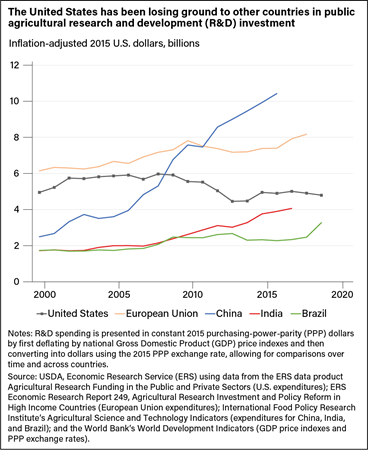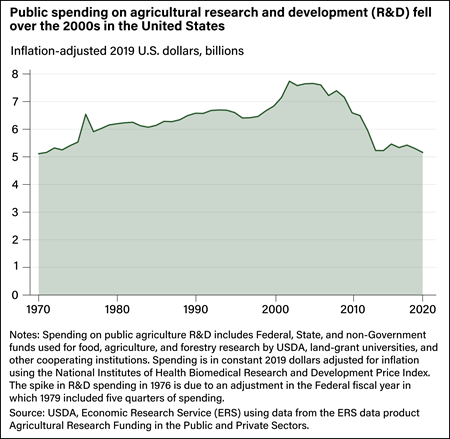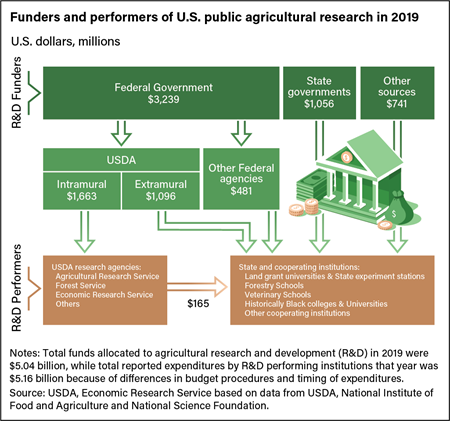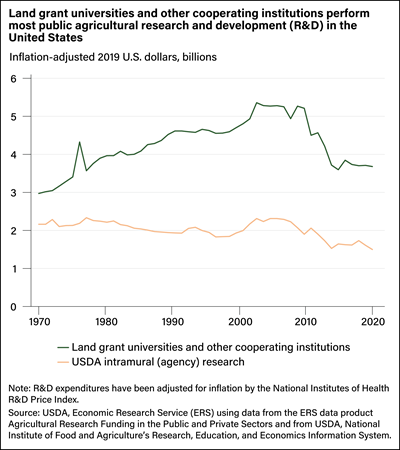
News
Business/Policy
United States
USDA report finds U.S. investment in public ag R&D has fallen significantly
June 8, 2022 by Keith Fuglie and Kelly P. Nelson, USDA, Economic Research Service
In the United States, public agricultural research and development (R&D), which includes any agricultural R&D conducted at universities or Government laboratories regardless of funding source, is supported through Federal-State partnerships. These partnerships provide an important complement to business R&D, providing scientific and technological innovations that raise U.S. agri-food system productivity.
This public R&D investment is the primary driver of long-term productivity growth in U.S. agriculture. In addition to increasing farm productivity, public agricultural R&D investment also supports improvements in natural resources and forestry management, helps advance rural development, enhances food safety and quality, and informs markets and policy. Research supported by the USDA, Economic Research Service (ERS) has found spending on public agricultural R&D from 1900 to 2011 generated, on average, $20 in benefits to the U.S. economy for every $1 of spending. However, this spending has been trending downwards. In 2019 (the last year for which complete statistics are available), public agricultural R&D spending in the United States totaled $5.16 billion, about a third lower than the peak in 2002 when spending was $7.64 billion (in constant 2019 dollars). At the same time, other countries have maintained or increased their spending on agricultural R&D.
Accounting for inflation when measuring public agricultural R&D spending
ERS researchers estimated the amount of R&D investment in constant dollars by adjusting nominal spending by an R&D price index. This R&D price index, the Biomedical Research and Development Price Index, was developed by the National Institutes of Health (NIH), is maintained by the Bureau of Economic Analysis, and spotlights the changing costs of resources devoted to R&D in life sciences fields, including agriculture. This measure indicates the rate of change in the cost of research inputs, including salaries and benefits of research personnel, prices paid for laboratory materials and equipment, and capital depreciation of research facilities. By adjusting nominal spending on agricultural R&D by this price index, it shows in real terms the amount of R&D conducted over time. Using this measure, ERS researchers found that U.S. public agricultural R&D spending peaked in 2002, and by 2019 spending had declined to roughly where it was in 1970.
The federal government funds most public agricultural R&D
Through different programs, Federal and State Government agencies and non-Government sources fund agricultural R&D. In 2019, the Federal Government funded $3.24 billion, or 64 percent of the total amount spent on public agricultural R&D. State governments funded an additional $1.06 billion, and non-Government sources funded $741 million. Most of the Federal funds for agricultural R&D were channeled through the USDA, where the funding was used for research performed by USDA agencies (referred to as intramural research) and research grants to universities and other cooperating institutions (extramural research). Other Federal agencies, including the National Science Foundation and the National Institutes of Health, also funded agricultural research primarily through grants to university colleges and schools of agriculture, forestry, and veterinary medicine. Non-Government sources of funds, primarily for research at universities, include industry grants, self-generated funds (such as patent licensing fees and product sales), and sources such as private nonprofit foundations and farm or producer organizations.
Of all U.S. funds allocated for public agricultural R&D in 2019, USDA administered more than half (55 percent), which was equally divided between intramural and extramural research. The USDA, Agricultural Research Service (ARS) and the R&D arm of the Forest Service received the largest share of USDA agency intramural research funds. USDA’s National Institute of Food and Agriculture (NIFA) administers most of the funds for extramural research funded by USDA. NIFA allocates one part of its research funds through “capacity grants” to State and territorial institutions on a formula basis and requires States to match the Federal grant. Capacity grants include:
- Hatch funds for State agricultural experiment stations of land-grant universities established under the Morrill Act of 1862;
- Evans-Allen funds for colleges of agriculture at historically Black colleges and universities established through the Morrill Act of 1890;
- McIntire-Stennis funds for forestry schools; and
- Animal Health and Disease Research Capacity Program funds (Section 1433 of the 1977 Farm Bill) for veterinary schools.
NIFA allocates another group of funds competitively, especially through the Agriculture and Food Research Initiative (AFRI). AFRI grants can be awarded to universities or other organizations and attract researchers from outside the traditional land-grant colleges of agriculture and forestry to conduct agriculture research.
A third set of NIFA funds is allocated through non-competitive research grants directed by Congress to support designated institutions or specific programs. The Tribal Colleges Research Grants Program and the Sustainable Agriculture Research and Education program are examples of congressionally directed special grants. In 2019, NIFA allocated nearly $1.1 billion for research. Of this, 38 percent was allocated through competitive grants, 26 percent through capacity grants, and the remaining 36 percent through directed special grant programs.
While the Federal Government funds nearly two-thirds of all public agricultural R&D in the United States, non-Federal institutions (land-grant universities and other cooperating institutions) perform about 70 percent of the agricultural research. USDA agencies such as ARS, ERS, and the Forest Service perform the other 30 percent of public agricultural R&D. Universities and State agricultural experiment stations usually focus research on the commodities and resource problems of greatest interest to their States. However, the scientific knowledge and technologies their research generates often have broader uses. University research also plays a vital role in training the next generation of agricultural scientists. USDA agency research, on the other hand, focuses on issues of national or regional importance, provides critical research infrastructure such as plant genetic resource conservation, and supports the regulatory and program functions of USDA agencies.
Of the non-Federal institutions performing publicly funded agricultural R&D in the United States, the land-grant universities and their State agricultural experiment stations established under the Morrill Act of 1862 account for more than half of total public agricultural R&D expenditures. State forestry and veterinary schools together accounted for 5 percent of public agricultural R&D in 2019. The share of public agricultural R&D performed at historically Black colleges and universities established through the Morrill Act of 1890 is small but increasing, from about 1 percent in 2000 to about 2 percent in 2019. The fastest rising component of the public agricultural R&D system, however, is classified as “other cooperating institutions,” whose share of public agricultural R&D expenditures increased from less than 1 percent in the 1990s to nearly 7 percent by 2019. These include universities outside the traditional land-grant system—reflecting the broad eligibility in the AFRI competitive grants program. The “other cooperating institutions” category also includes strengthened Federal support for Tribal colleges and universities.
China has become the world’s largest funder of agricultural R&D
ERS researchers compared spending for public agricultural R&D in the United States with other large countries and the European Union. China, the largest importer of U.S. agricultural goods, and Brazil, a major international competitor with the United States in agricultural exports, both increased their agricultural R&D funding during the past two decades. China has become the largest funder of agricultural R&D in the world, surpassing the United States and the European Union. India, another country with a large agricultural sector, also has increased its public R&D spending. Lower U.S. spending on agricultural R&D may be partially offset by private sector spending, but comprehensive information on private agricultural R&D investment by country is not available. Nonetheless, present trends may affect the U.S. role as a global leader in agricultural sciences and could lead to reduced U.S. agricultural trade competitiveness if U.S. agricultural productivity growth slows compared with other countries.



